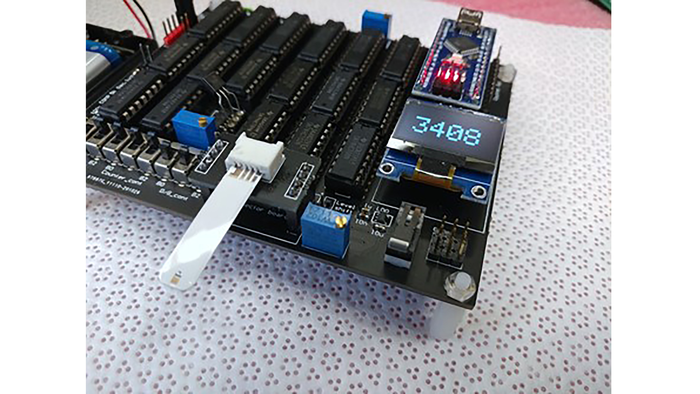WASHINGTON, February 1, 2022 — Developing rapid clinical testing for cerebrospinal fluid (CSF) leaks after trauma, surgery, tumors, and other defects are vital, because such leaks can cause life-threatening conditions, such as meningitis and intercranial infection.

Credit: Minghan Xian, Chan-Wen Chiu, Patrick Carey, Chaker Fares, Liya Chen, Rena Wu, Fan Ren, Cheng-Tse Tsai, Siang-Sin Shan, Yu-Te Liao, Josephine F Esquivel-Upshaw, Stephen J. Pearton
WASHINGTON, February 1, 2022 — Developing rapid clinical testing for cerebrospinal fluid (CSF) leaks after trauma, surgery, tumors, and other defects are vital, because such leaks can cause life-threatening conditions, such as meningitis and intercranial infection.
Detecting such leaks using primary conventional methods, such as immunofixation electrophoresis (IFE) and enzyme-linked immunosorbent assay (ELISA), require hours or days to turn around results. Secondary methods, such as optical techniques that rely on MRI, often fail to identify the specific leak site.
In Journal of Vacuum Science & Technology B by AIP Publishing, researchers from the University of Florida and Yang Ming-Chiao Tung University developed a single-use sensor strip that can be used with a circuit board, like a hand-held glucometer, to detect cerebrospinal fluid leaks.
Cerebrospinal fluid is present in the brain and spinal cord and provides critical physiological functions, such as shock absorption and waste removal. CSF directly links extracranial space to subarachnoid space, a compartment within which are the major cerebral blood vessels.
In addition to trauma, surgery and congenital defects, CSF leaks are likely to occur because of obesity, high intercranial pressure, and obstructive sleep apnea. Cerebrospinal leaks can come out through the nose or the ears.
“We were surprised to find out that our detection method could not only provide the result within one second, but our detection limit was also a lot more sensitive for a very diluted concentration than existing detection methods,” said co-author Minghan Xian.
The researchers collected nine human clinical samples from a Florida hospital and introduced the test fluid into a small liquid channel on the tip of the sensor strips. The liquid channel held electrodes, which contained antibodies on the surface specific to proteins found only in human cerebrospinal fluid. Once the test fluid was inserted into the liquid channel, a few short electrode pulses were sent through the electrodes. The circuit board then analyzed the signal and produced a four-digit number that correlates to the concentration of the protein, called beta-2-transferrin, found in CSF.
The researchers were able to detect beta-2-transferrin in the fluid sample even when other proteins and salts were present and from samples across different patients.
The researchers used similar technology to detect proteins in SARS-CoV2, the virus that causes COVID-19. Their next phase of research will focus on detecting various cancer and heart disease biomarkers.
###
The article “Digital biosensor for human cerebrospinal fluid detection with single-use sensing strips” is authored by Minghan Xian, Chan-Wen Chiu, Patrick Carey, Chaker Fares, Liya Chen, Rena Wu, Fan Ren, Cheng-Tse Tsai, Siang-Sin Shan, Yu-Te Liao, Josephine F. Esquivel-Upshaw, Stephen J. Pearton. The article will appear in Journal of Vacuum Science & Technology B on Feb. 1, 2022 (DOI: 10.1116/6.0001576). After that date, it can be accessed at https://aip.scitation.org/doi/full/10.1116/6.0001576.
ABOUT THE JOURNAL
Journal of Vacuum Science & Technology B, an AVS journal published by AIP Publishing, is devoted to publishing reports of original research, letters, and review articles covering multiple disciplines with a focus on microelectronics and nanotechnology. See https://avs.scitation.org/journal/jvb.
ABOUT AVS
AVS is an interdisciplinary, professional society with some 4,500 members worldwide. Founded in 1953, AVS hosts local and international meetings, publishes five journals, serves members through awards, training and career services programs and supports networking among academic, industrial, government, and consulting professionals. Its members come from across the fields of chemistry, physics, biology, mathematics, engineering and business and share a common interest in basic science, technology development and commercialization related to materials, interfaces, and processing. https://www.avs.org
###
Journal
Journal of Vacuum Science & Technology B Nanotechnology and Microelectronics Materials Processing Measurement and Phenomena
DOI
10.1116/6.0001576
Article Title
Digital biosensor for human cerebrospinal fluid detection with single-use sensing strips
Article Publication Date
1-Feb-2022




